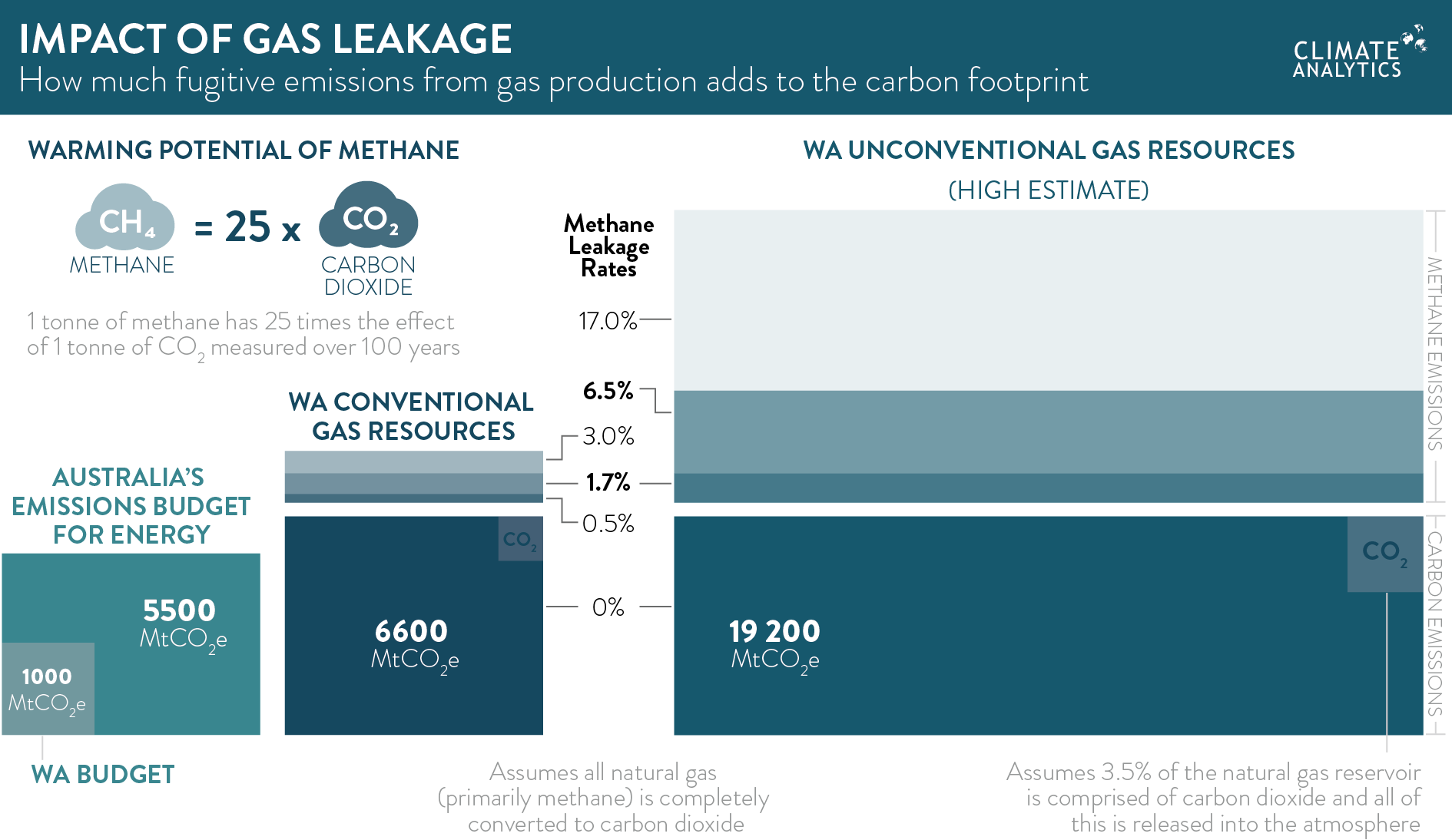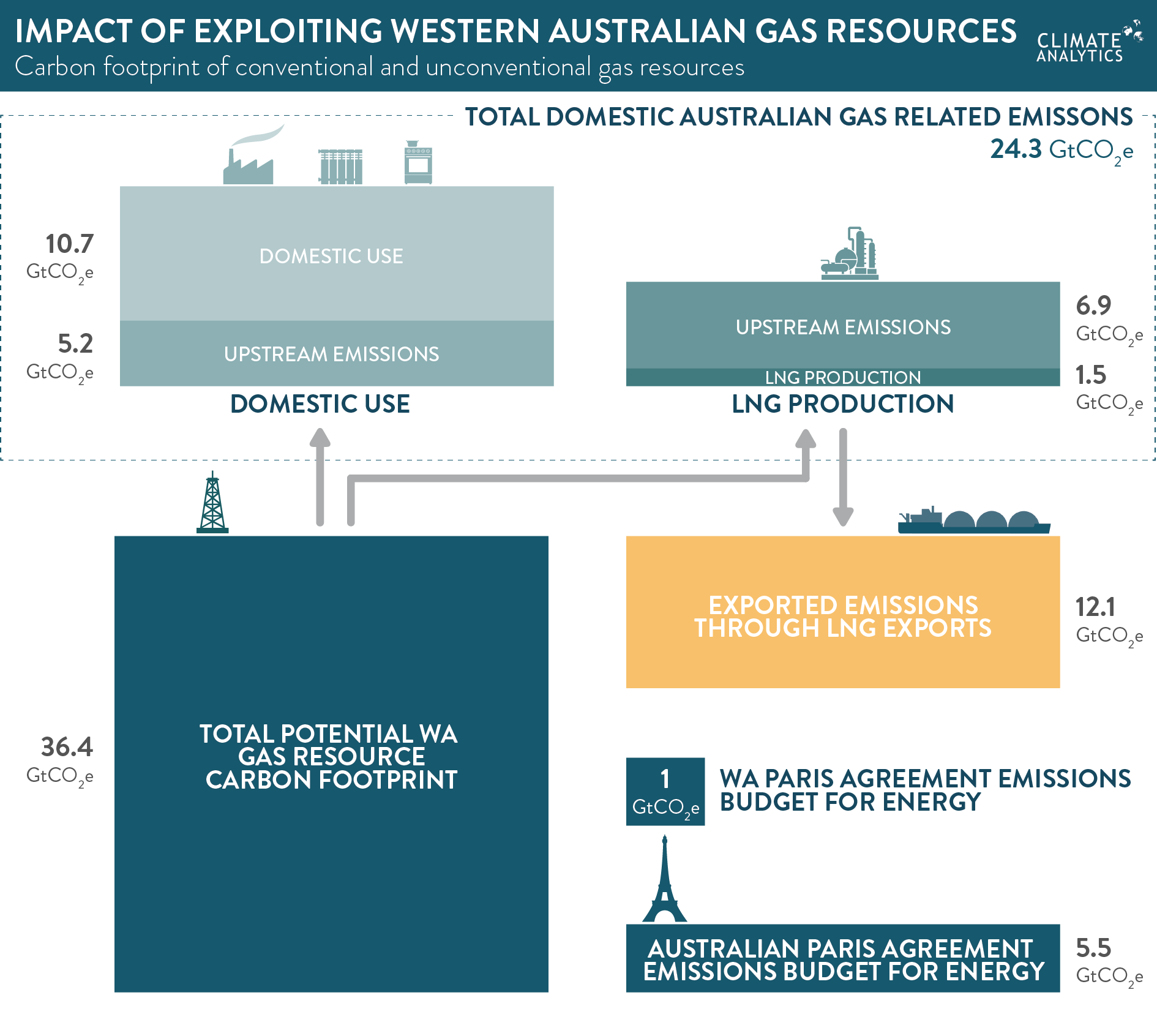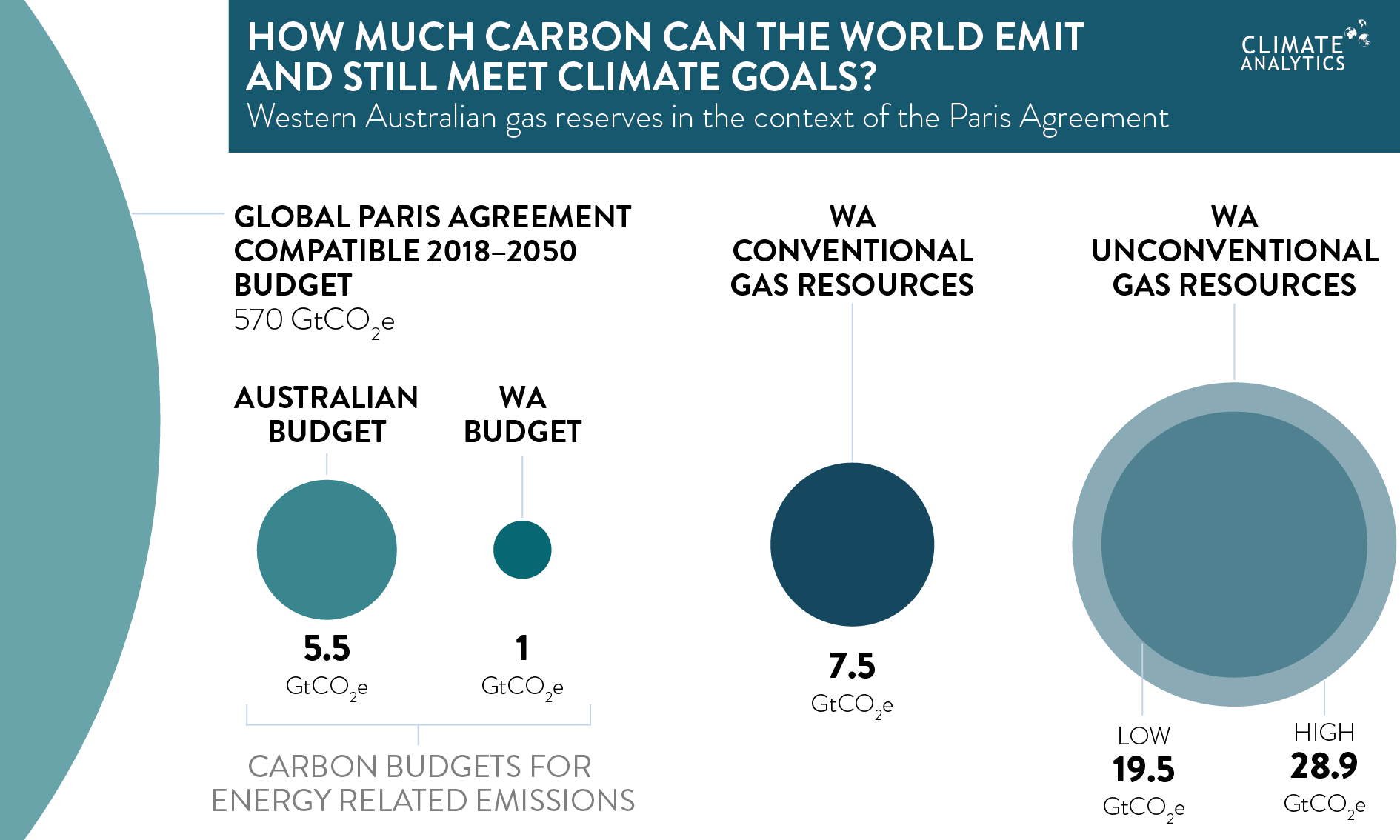Western Australia's gas gamble - implications of natural gas extraction in WA
Authors
Bill Hare, Niklas Roming, Ursula Fuentes Hutfilter, Michiel Schaeffer, Matt Beer
Share

Summary
With its vast reserves, Western Australia is a global player when it comes to natural gas. By the end of 2018, its liquefied natural gas (LNG) production will account for around 11% of global capacity. Any decision Western Australia makes when it comes to new gas projects will have a global impact. By the same token, how the global energy markets respond to the global shift away from fossil fuels and towards renewable energy will have serious implications for the profitability of current and potential natural gas projects in Western Australia.
At present these developments focus on conventional natural gas resources but now the development of unconventional resources, including exploiting shale gas in the Canning Basin using hydraulic fracturing (fracking) is under discussion. In addition to environmental impacts associated with fracking, these resources contain much more energy and carbon than conventional resources and using them would entail large carbon emissions. Additionally, because shale gas and other unconventional resources are so much more difficult to extract, they also have a substantially higher risk of leakage and losses of methane – a powerful greenhouse gas released during the extraction process.
As a Paris Agreement signatory, Australia – and thus by extension Western Australia – need to reduce their greenhouse gas emissions to be in line with the climate treaty’s long-term objective to hold global temperature rise to “well below” 2°C above pre-industrial levels and pursue efforts to limit it to 1.5°C. The world has warmed by 1°C since the Industrial Revolution and even at this level of warming Australia is already experiencing severe climate impacts – from coral reef loss to devastating bushfires linked to increasingly long and intense heat waves and droughts. Limiting warming to 1.5°C is particularly important to Australia as it represents a chance to avoid much worse climate impacts.
To keep the chance to limit dangerous climate change within reach and meet the goals set out in the Paris Agreement, there’s a limited amount of carbon the world can emit collectively – the so-called global carbon budget. Australia’s share of this carbon budget – and Western Australia’s portion of it – is correspondingly limited. The global carbon budget is shrinking rapidly even without any new fossil fuel developments. We show in this report that any new gas development in Western Australia based on unconventional resources – globally significant by their sheer scale – would undermine both Australia’s and the world’s efforts to meet the Paris Agreement’s climate goals.
By signing the Paris climate agreement, governments, including Australia, agreed that greenhouse gas emissions must reach zero globally within the second half of this century, which spells trouble also for the natural gas market, as demand is likely to peak within the next ten to fifteen years. As the world begins to implement the Paris Agreement, governments are stepping up efforts to cut emissions and roll out renewable energy. The combination of rapid progress in renewable energy and storage technologies and the continually falling costs, which is making renewables more cost-effective than fossil fuels, including natural gas, in a growing number of markets also casts doubt on the wisdom of developing new gas projects in Western Australia.
At the same time, Western Australia is uniquely placed to take advantage of the economic opportunity the Paris Agreement represents as the world transitions to a low-carbon future. Not only is it rich in minerals needed to make the global low carbon transformation possible but it also has enormous and easily accessible solar, wind and geothermal renewable energy resources.
Domestic carbon footprint
The domestic emissions from full exploitation of Western Australia’s conventional gas reserves for both domestic use and LNG exports present major challenges for the State to comply with a Paris Agreement-compatible carbon budget.
Under the Paris Agreement, Western Australia will need to move from gas to renewable energy sources by 2050 for its domestic energy needs and as well make very large emission reductions in all phases of LNG production and processing.

Scenarios for complete use of conventional gas reserves and resources for domestic WA use (business as usual or a Paris Agreement scenario) with remainder of gas resource not used domestically exported as LNG. Carbon footprint compared to WA Paris Agreement compatible energy emissions budget and with the natural gas component of this budget. The Paris Agreement domestic energy scenario shows the carbon footprint for a phase out of domestic gas use in WA by 2050, however the LNG footprint remains high so that the overall emissions far exceed the total emissions budget for the WA energy system. This points to the need for emissions related to LNG production to be reduced very substantially.
The domestic emissions expected from all conventional gas reserves are about 40-75% above what Western Australia’s energy sector could emit in order to comply with the Paris Agreement.
- Upstream emissions from domestic use of natural gas – including fugitive emissions during extraction, processing, handling and transportation – would be about 300 million tonnes of CO2 equivalent (0.30 GtCO2e).
- Emissions from direct use in WA – power production, mineral processing and LNG production add approximately 1.4 billion tonnes of CO2 equivalent (1.4 GtCO2e)
- Total domestic carbon footprint of conventional gas reserves is about 1.8 billion tonnes of CO2 equivalent emissions (1.8 GtCO2e). This is about 800 million tonnes above the Paris Agreement-compatible emissions budget for Western Australia, which is one billion tonnes of CO2 equivalent (1 GtCO2e). This budget is for the whole energy sector including power, industry, transport and buildings, not just those parts that depend on natural gas.
The domestic carbon footprint from Western Australia’s unconventional gas resources is about three times what Australia is allowed to emit in order to comply with the Paris Agreement. The carbon footprint of Canning Basin resources alone is equivalent to about double this budget.
- Upstream emissions from domestic use of all unconventional resources – including fugitive emissions, extraction, processing, handling and transportation – would between 8 and 12 billion tonnes of CO2 equivalent (8-12 GtCO2e), and all would likely come from Western Australia.
- Emissions from direct domestic use of gas and LNG processing add 6-7 billion tonnes of CO2 equivalent (6-7 GtCO2e), with the majority of these emissions occurring in Western Australia.
- The total upstream and direct emissions from use of all unconventional resources is about three times Australia’s estimated emissions budget under the Paris Agreement, which is 5-6 billion tonnes of CO2 equivalent (5.5 GtCO2).

The domestic carbon footprint from unconventional gas resources would fundamentally undermine Western Australia and Australia’s contribution to global efforts to limit warming to 1.5°C.
Canning Basin and other unconventional gas resources are not needed in Western Australia or Australia for the energy transformation required to meet Paris Agreement goals.
- While gas will likely play a role in the transition phase towards a zero-CO2 emissions (e.g. 100% renewable) energy system, Australia and Western Australia’s gas demand in this transition can easily be met without any need for WA’s unconventional gas resources.
- In a Paris Agreement-compatible energy transition gas consumption would start declining in the 2020s and reach zero by 2050, with all gas use replaced by renewable energy alternatives.

This shows the carbon footprint for one scenario for complete use of conventional and the present high estimate of unconventional WA gas resource with substantial domestic use (43%) and the remainder use for LNG processing and export.

Global carbon footprint
The carbon footprint of Western Australia’s total gas reserves is globally significant and is equivalent to 4.7%-6.4% of the global energy system carbon budget under the Paris Agreement.
- Western Australia’s conventional gas reserves have a carbon footprint equivalent to about 1.3% of the global carbon budget under the Paris Agreement.
- Unconventional gas has a carbon footprint equivalent to about 3.4.% -5.1% of the Paris Agreement-compatible carbon budget for until 2050.
- The carbon footprint of Canning Basin resources alone is equivalent to about 2.3%-3.6% of a Paris Agreement-compatible global carbon budget. This is much higher than Australia’s share of present global energy-related CO2 emissions (about 1%).
The world does not need Canning Basin nor other unconventional gas to transition to a zero-emissions energy system.
- The global gas market does not need the additional resources from the proposed development of Canning Basin and other unconventional gas in Western Australia.
- Global proven gas reserves are already sufficient to meet the demand under Paris Agreement-compatible energy and emission pathways. In fact, less than half of these reserves can be used by 2050 to stay within the Paris Agreement carbon budget.
Investing in unconventional gas production and transport infrastructure risks a lock-in of carbon-intensive energy mix and stranded assets.
- Gas demand will likely peak and decline within 10-15 years as the world implements the Paris Agreement.
- Present real economy technology trends indicate it is unlikely that gas with Carbon Capture and Storage (CCS) will be deployed at scale in power systems as renewable energy becomes cheaper and more flexible.
- Exploitation of Canning Basin and other unconventional gas resources in Western Australia is likely lead to large stranded assets, either through investments in pipelines within Australia or LNG export facilities.
In the context of a slump in gas demand expected as the world implements the Paris Agreement, and with extraction and transport costs likely be in the upper end of the global supply cost curve, the profitability of exploiting the Canning gas resources is in doubt.

Global energy transition as an opportunity for Western Australia
Western Australia has an unusually large and accessible combination of renewable resources, notably solar, wind and geothermal, as well as mineral resources critical to the global low-carbon transformation.
Western Australia will need to play its role in reducing greenhouse gas emissions over the next several decades, within the context and framework of Australia’s evolving policy settings. While its energy intensive sector will be a relevant and important consideration in how fast greenhouse gas emissions need to be reduced compared to the national average, ultimately all CO2 emissions from fossil fuel use will need to be reduced to zero over the next three to four decades. The present lack of a coherent federal policy framework to meet Australia’s commitments under the Paris Agreement does not exempt Western Australia from considering the greenhouse gas emissions that would result from specific industrial development proposals. Almost all of Australia’s States and Territories have set goals to achieve net zero emissions by 2050. The only exceptions are Western Australia and the Northern Territory.
Many large companies active in Western Australia in the energy and resources sector are already actively exploring transition possibilities for their enterprises to significantly reduce CO2 and other greenhouse gas emissions, while building and maintaining their core business.
The global market opportunity for zero carbon energy created by the Paris Agreement presents an unprecedented opportunity for Western Australia to make an orderly and economically beneficial transition from a leading LNG exporter to a global renewable energy superpower.
Western Australia has a natural comparative advantage in terms vast renewable resources, high level technical and engineering capabilities, infrastructure and proximity to Asian energy markets to develop a carbon free energy system for domestic use and exports of renewable energy (electricity or energy carriers such as ‘Green’ hydrogen) to take the place of LNG and other high carbon energy carriers in international markets.

Selected media coverage
How the Gorgon gas plant could wipe out a year’s worth of Australia’s solar emissions savings, ABC News Australia, 21 June 2018
‘Problem in waiting’: why natural gas will wipe out Australia’s emissions gains, The Guardian, 12 November 2018















